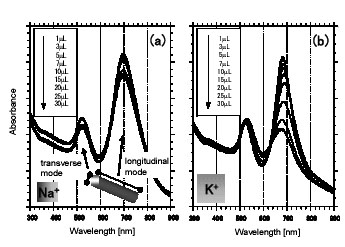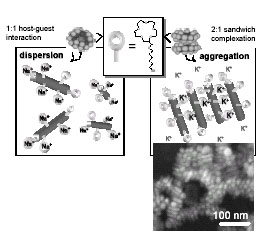Hiroshi Nakashima and Kazuaki Furukawa
Materials Science Laboratory
Herein, we report the selective ion sensing of physiologically important cations such as Na+ and K+ using the LSPR absorption of gold NRs with thiol-modified crown ethers in response to dispersed and aggregated gold NRs. The crown ethers attached themselves covalently to the gold NR surface due to the high affinity of the thiol group to gold [1].
Figure.1 shows the absorption spectra of the gold NRs (length: 40 nm, diameter: 10 nm) with 15-crown-5-SH on the addition of NaCl or KCl solution. The gold NRs exhibited two plasmon absorption maxima around 680-700 and 520 nm, corresponding to a longitudinal mode along the long axis and a transverse mode perpendicular to the long axis, respectively. When we increased the amount of added KCl solution, the longitudinal absorption intensity of the NRs gradually decreased and the peak was blue-shifted. The spectral change was caused by the formation of NR aggregates. The recognition of K+ is proposed via a sandwich complex of 2:1 between 15-crown-5 moiety and K+ (Fig. 2). This triggered the coupling of the plasmon absorbance as a result of the NRs proximity to each other. In the presence of Na+, the absorption spectra profiles of gold NRs with 15-crown-5-SH remained largely unchanged. The results originated from the fact that Na+ was recognized by simple 1:1 host-guest interactions that correlated with the close fit of the cation to the crown cavity. Consequently, the dispersed or aggregated states of the gold NR complex, which is dominated by the ion sensing mechanism, result in further spectral changes.
The LSPR properties of gold NRs can be continuously tuned by adjusting their aspect ratio from the ultraviolet to the infrared region, including the near-infrared region where tissue transmissivity is at its highest. The functionalized gold NRs with various biomolecules will provide nano detection platforms such as those used for diagnostic applications and biological imaging, and function as a colorimetric reporter via the highly sensitive LSPR properties.
[1] H. Nakashima, et al., Chem. Commun. (2007) 1080.
 |
 |
||||
|
|